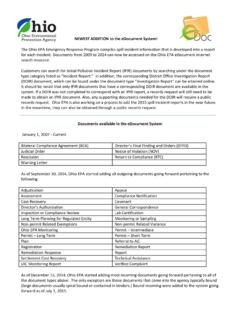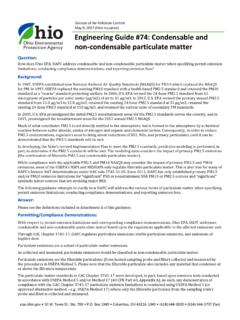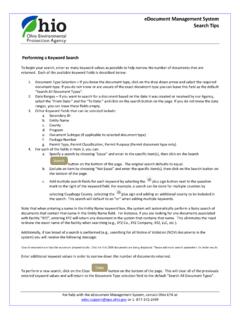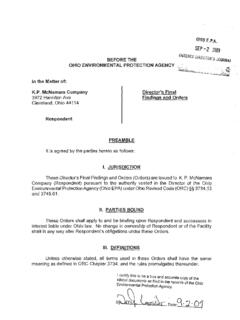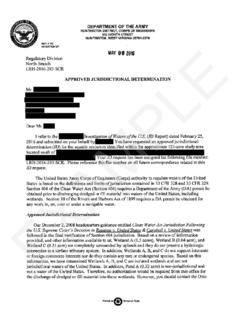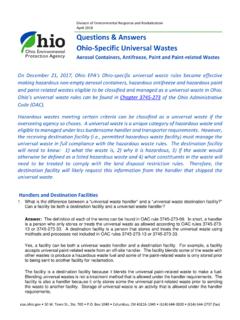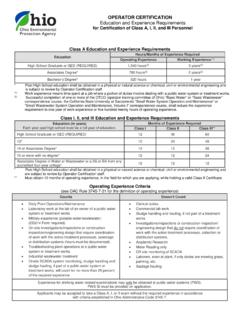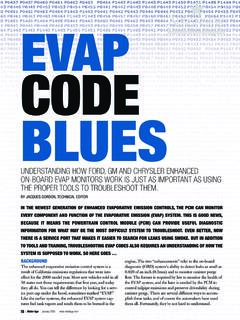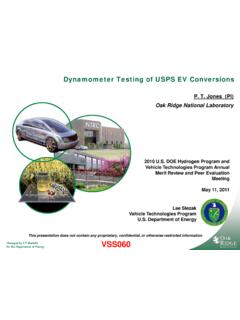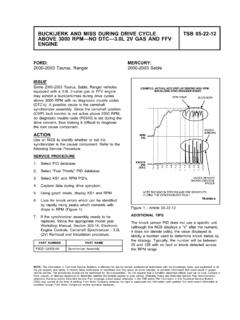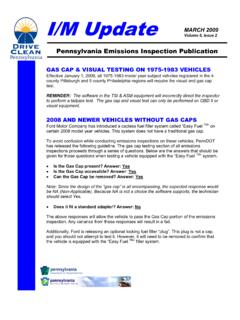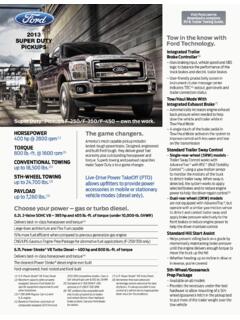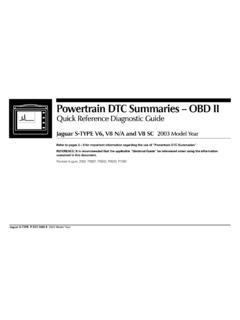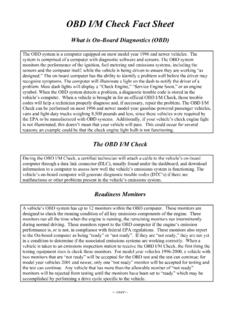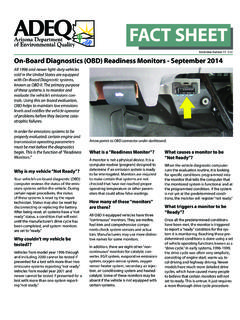Transcription of On Board Diagnostic (OBD) Readiness and Drive Cycle ...
1 On Board Diagnostic (OBD) Readiness and Drive Cycle information OBD Readiness Your vehicle performs up to 11 Diagnostic checks of specific emission control components such as engine, transmission, fuel systems and other emissions controls. Each Diagnostic check communicates with a monitor called a Readiness monitor. These Diagnostic checks are performed while the vehicle is driven. Certain driving conditions must be met to determine if all components are functioning within allowable standards. If all Diagnostic checks have been performed, the computer reports systems as ready. If Diagnostic data has been erased during vehicle repairs or through battery disconnection the computer reports systems as incomplete or not ready. Vehicles are rejected from testing when these Diagnostic checks are not completed. This sophisticated system serves as an early indicator of exceeding the vehicle emissions standards, increasing air pollution emissions and of potential engine damage.
2 The OBD (On Board Diagnostic ) system is more like a computer monitoring system. An OBD monitor is a computer test or series of computer tests used to determine if an emission control device or system is failing. The vehicle performs the self- Diagnostic computer test when the vehicle is driven. This is commonly referred to as a Drive Cycle . If possible, when working on a vehicle either before or after an E-Check OBD II test; do not clear the Diagnostic Trouble Codes (DTC s) so that the check engine light remains on after the repair(s). Therefore, if it was the correct repair, the check engine light will turn off on its own while driving the vehicle through its Drive Cycle and signals to the driver that the vehicle is ready to be tested. If the check engine light does not turn off, then additional repair(s) may be required. Remind your repair technician that you prefer to keep the check engine light on after the repair(s) if possible.
3 If the repairs require the computer DTC s to be cleared or a battery disconnect (which also clears DTC s), then be sure to Drive the vehicle for at least two or three days (older vehicles may take more time) including both highway and city miles. This will result in setting the OBD monitors to ready and ready for an emissions test. Unfortunately, when the DTC s are cleared it turns the check engine light off and it is a guessing game as to when the computer monitors are ready. The generic Drive Cycle below may or may not be helpful but it will give you a better idea of what driving parameters usually need to be met. This may need to be repeated 2 to 5 times depending on the make, model and age of the vehicle. *Do this all at the same time and not in pieces (does not need to be exact) 1. Let the vehicle sit for 8 hours 2. Start the vehicle and let it warm up 3. Drive for at least 10 minutes at highway speeds (55 mph or more) 4. Drive for at least 20 minutes in urban traffic with at least 4 idle periods Check your vehicle s owner s manual, contact your local dealership or visit and look under Forms and Publications for basic information on Drive cycles.
4 You can also visit the web addresses at the bottom of this page. Some vehicle owner s manuals provide information on how a vehicle owner can determine if the Diagnostic system is ready for emissions checking by performing a certain procedure. Based on these owner s manuals, to check for Readiness , turn the ignition switch to the ON position, but do not crank or start the engine. The check engine light may light solidly then either turn off, remain illuminated or blink multiple times. If the check engine light blinks multiple times, the Readiness codes are not likely set. If the light stays on or turns off, the Readiness codes are likely set. Note that when the engine is started, the check engine light should turn off unless there are emissions control problems. Many vehicle manufacturers now include these Drive cycles in the vehicle s owner s manual. Others will provide information in Technical Service Bulletins (TSB).
5 Please note, some specific published Drive cycles are intended to reset all monitors in the shortest amount of time as possible. In many cases, a few days of normal driving, both city and highway, will reset the monitors. For general information regarding OBD II, including very specific Drive cycles for ford and GM (included in the following pages) vehicles (including which monitors are reset during specific driving events), see the following web site: Readiness Check The following paragraphs detail procedures on how to determine if the OBD II monitors are ready for E-Check. For newer ford /Lincoln/Mercury vehicles, to determine if the vehicle is ready for E-Check, turn the ignition key to the on position for 15 seconds without cranking the engine. If the service engine soon indicator blinks eight times, it means that the vehicle is not ready for E-Check; if the service engine soon indicator stays on solid, it means that the vehicle is ready for E-Check testing.
6 This procedure was included in the Owner s Manual for a 2012 ford Focus. This same procedure may apply to other models and model years ford /Lincoln/Mercury vehicles. For Jeep, Chrysler and Dodge, the owner s manual states that the vehicle has a simple ignition key-actuated test, which you can use prior to going to the test station. To check if your vehicle s OBD II system is ready, you must do the following: 1. Turn the ignition switch to the ON position, but do not crank or start the engine. If you crank or start the engine, you will have to start this test over. 2. As soon as you turn the ignition switch to the ON position, you will see the MIL symbol come on as part of a normal bulb check. 3. Approximately 15 seconds later, one of two things will happen: a. The MIL will flash for about 10 seconds and then return to being fully illuminated until you turn OFF the ignition or start the engine. This means that your vehicle s OBD II system is not ready and you should not proceed to the E-Check station.
7 B. The MIL will not flash at all and will remain fully illuminated until you turn OFF the ignition or start the engine. This means that your vehicle s OBD II system is ready and you can proceed to the E-Check station. Honda/Acura, from the owner s manual, to check if the Readiness codes are set, turn the ignition switch to the ON (II) position, without starting the engine. The MIL will come on for 20 seconds. If it then goes off, the Readiness monitors are set. If it blinks five times, the Readiness monitors are not set. Drive Cycles to Reset OBD II Monitors The following paragraphs include information for manufacturer specific information regarding Drive cycles. If your vehicle make is not listed below, the following generic Drive cycles are available: #gm_supp-reqs Some of these generic Drive cycles are identical to the Drive Cycle included for GM vehicles (Chevy, Buick, Cadillac, GMC, Pontiac, Oldsmobile), which is included below.
8 BMW: Drive Cycles are not included in the BMW public web site or owner s manual. The following Drive Cycle was found via an internet search: Chrysler/Dodge/Jeep: Drive Cycles are not included in the Chrysler/Dodge/Jeep public web site or owner s manual. The following Drive Cycle was found via an internet search: Generic Drive Cycle on Dodge forum: ford : Newer ford owner s manuals include a Drive Cycle , which is as follows: The OBD-II system is designed to check the emission control system during normal driving. A complete check may take several days. If the vehicle is not ready for E-Check testing, the following driving Cycle consisting of mixed city and highway driving should be performed: 15 minutes of steady driving on an expressway/highway followed by 20 minutes of stop-and-go driving with at least four 30-second idle periods. Allow the vehicle to sit for at least eight hours without starting the engine. Then, start the engine and complete the above driving Cycle .
9 The engine must warm up to its normal operating temperature. Once started, do not turn off the engine until the above driving Cycle is complete. If the vehicle is still not ready for E-Check testing, the above driving Cycle will have to be repeated. GM (Chevy, Buick, Cadillac, GMC, Pontiac, Oldsmobile): Drive Cycles are not included in the manufacturer s public web site or owner s manual. The following Drive Cycle is from : To perform an OBDII Driving Cycle , do the following: 1. Cold Start. In order to be classified as a cold start the engine coolant temperature must be below 122 F and within 11 F of the ambient air temperature at startup. Do not leave the key on prior to the cold start or the heated oxygen sensor Diagnostic may not run. 2. Idle. The engine must be run for two and a half minutes with the air conditioner on and rear defroster on. The more electrical load you can apply the better.
10 This will test the O2 heater, passive air, purge "no flow", misfire and if closed loop is achieved, fuel trim. 3. Accelerate. Turn off the air conditioner and all the other loads and apply half throttle until 55mph is reached. During this time the misfire, fuel trim, and purge flow diagnostics will be performed. 4. Hold Steady Speed. Hold a steady speed of 55mph for 3 minutes. During this time the O2 response, air Intrusive, EGR, purge, misfire, and fuel trim diagnostics will be performed. 5. Decelerate. Let off the accelerator pedal. Do not shift, touch the brake or clutch. It is important to let the vehicle coast along gradually slowing down to 20 mph. During this time the EGR, purge and fuel trim diagnostics will be performed. 6. Accelerate. Accelerate at 3/4 throttle until 55-60mph. This will perform the same diagnostics as in step 3. 7. Hold Steady Speed. Hold a steady speed of 55mph for five minutes.
